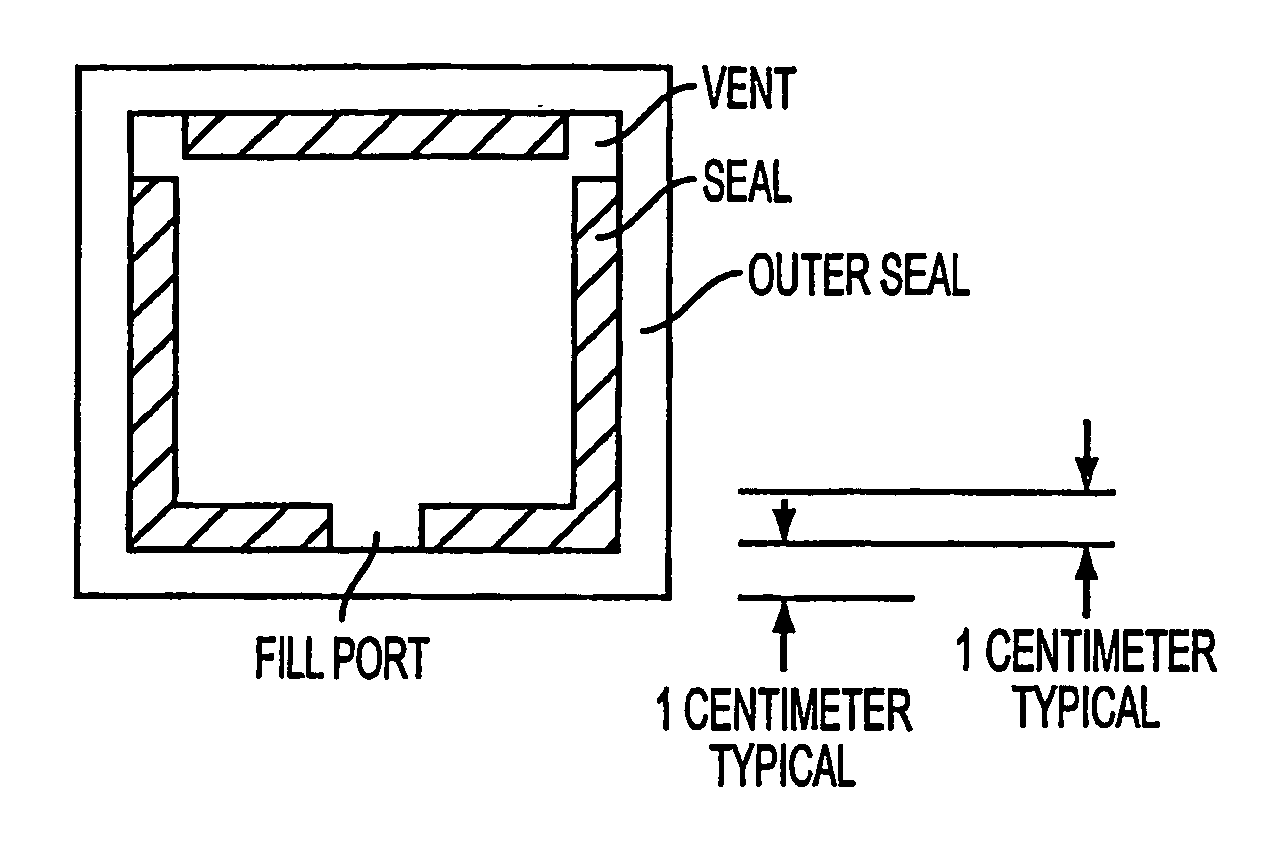Problems with Previous Procedures and Materials
If the filling pressure of the
polymer solution is increased in order to obtain a reasonable fill time, this
high pressure breaks the glass, even when a reinforcing clamp on the glass is used.
In this case,
polymerization must usually be fairly complete, because most unpolymerized monomers would render the finished gel toxic.
Thus, if the seal between the two cover sheets of e.g. glass is ruptured and solvent evaporates, the switching temperature of the
light valve will drift.
These interchain bonds may also cause a
hysteresis in the switching characteristics of the
light valve, such that the switching temperature on heating is higher than the switching temperature on cooling.
This would be useful, for example, in computer memories, but may be a problem for light valves.
A further problem with this
copolymer is that it slowly reacts with the solvent, by ester hydrolosys.
Catalysts for initiating
polymerization, or crosslinking, or gelling, or curing, may be unsatisfactory for the following reasons:
Ultraviolet light activated photoinitiators do not work with
glass cover sheets because glass is not transparent to the wavelengths (typically the mercury emission line at 316 nanometers) required to activate most UV photoinitiators.
Visible
light activated photoinitiators are usually unsatisfactory because they are slow and also because their reaction products generally impart to the light valve the property of yellowing by
sunlight and / or
oxygen, which is sometimes undesirable.
When the
ascorbic acid is replaced with a
hypophosphite salt as the
reducer that is used with the
hydrogen peroxide oxidizer, the yellowing problem is solved, but the time for the solution to crosslink and gel after mixing in the two catalyst components and filling is extended to 3 hours, which is often too slow.
The N-vinyl
caprolactam monomer with a water solvent is not suitable for this new process due to its limited
solubility in water at
room temperature, and also due to its slow polymerization, which must be driven by harsh conditions such as temperatures above the switching temperature of the light valve.
A further problem is that the poly N-vinyl
caprolactam “backbone” has pendant
lactam rings that stearicly hinder the backbone from making the conformational changes necessary for phase separation with good sharpness.
The N-
isopropyl acrylamide monomer, although it polymerizes rapidly and completely under mild conditions, is also unsuitable for this new process, due to its limited
solubility in water (both of these monomers are solids at 20° C., which correlates with their low
solubility at that temperature).
However, if the polymer is formed by the polymerization of an
unsaturated monomer, as is usually the case, then this vinyl unsaturation will make the monomer slightly more hydrophobic than the polymer that it forms, which does not have the unsaturation.
This solubility difference makes it difficult to find a monomer which both exhibits
precipitation on heating when it is in polymer form, and which is also sufficiently soluble at temperatures below the
precipitation temperature of the polymer.
This difficult requirement generally implies that the monomer is a liquid at e.g. 20° C. below the
precipitation temperature of the polymer, thus increasing its heat of solution and solubility.
However, if the polymerization occurs above the switching temperature of the light valve, the optical properties usually suffer: e.g. the switching from clear to opaque is less sharp; i.e. it occurs over a larger temperature range, and there may also be a permanent
haze when the light valve is in its clear (or transmissive) state.
However, although the TBA and the MBA crosslinker, typically at 0.2% concentration, are poorly soluble in water, they are adequately soluble in the DEA+water solution because the DEA couples them into solution, due to their similar molecular structures.
This
gel time is desirable because if too much polymerization occurs during filling, the switching temperature and other optical properties may not be adequately uniform.
Pentamethyl piperidone, typically at 0.2% concentration, harmlessly decomposes free radical generators, e.g.
hydrogen peroxide and
ozone, and then regenerates itself, unlike sacrificial stabilizers, which lose their effectiveness.
Immediately when parts A and B leave the two cylinders of the
syringe cartridge, they enter an e.g.
static mixer with 10 mixing elements; this
static mixer should have a small
diameter to promote turbulence and consequent good mixing of the parts A and B. Poor mixing results in objectionable swirl patterns in the polymerized sample when it is close to its switching temperature.
Before the mixed parts A and B are injected into the sample, the
oxygen-containing air in the cavity must be removed so that it doesn't prevent uniform polymerization.
K and E are relatively expensive because they are manufactured in small quantities.
This diisocyanate crosslinker is preferred because it reacts relatively rapidly at 20° C. and is also resistant to
thermal oxidation and
sunlight, because it is also based on a saturated
hydrocarbon, and especially because it is soluble in K and E. Poor
mutual solubility of any of the ingredients results in an only partial cure.
These fillers also increase viscosity or
thixotropy before cure, which makes homogeneous mixing more difficult, but may allow handling of the cover sheet / cavity / cover sheet sandwich before the outer
sealant has cured.
 Login to View More
Login to View More 


